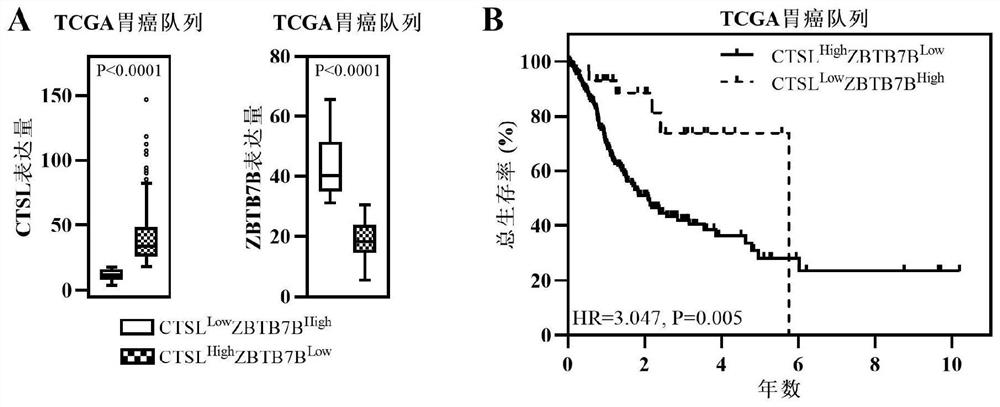Double-gene combination and application thereof to personalized candidate evaluation of gastric cancer immunotherapy patient
A double-gene, gastric cancer technology, applied in the fields of biotechnology and medicine, can solve the problem of gastric cancer lacking a tumor microenvironment molecular subtype system, and achieve the effects of simple means, poor prognosis, and accurate survival prognosis
- Summary
- Abstract
- Description
- Claims
- Application Information
AI Technical Summary
Problems solved by technology
Method used
Image
Examples
Embodiment 1
[0061] Example 1: Identification of High-Risk Immune Overdrive Subgroup Patients in the TCGA Gastric Cancer Patient Cohort
[0062] Step 1. Obtain the RNA-Seq expression data of tumor tissue genes and survival prognosis data of gastric cancer patients from the Genomic Data Commons Data Portal;
[0063] Step 2. Analyze the overall survival rates of dual genes CTSL and ZBTB7B respectively. Set the total number of samples as N, and sort the expression of the genes to be tested from high to low, respectively EXP 1 、EXP 2 ...... EXP N , divided into high expression group and low expression group, the first round will EXP 1 High expression group H 1 , EXP 2 to EXP N low expression group L 1 , using Kaplan-Meier analysis and log-rank test to calculate H 1 group compared to L 1 Group survival risk value (hazard ratio, HR) HR 1 and a significant P value P 1 ; In the second round, EXP1 to EXP2 were classified as high expression group H 2 , EXP 3 to EXP N low expression grou...
Embodiment 2
[0068] Example 2: Identification of a high-risk immune overdrive subgroup of patients in the GSE15459 gastric cancer patient cohort
[0069] Step 1. Obtain the microarray expression data and survival prognosis data of tumor tissue genes of GSE15459 gastric cancer patients from Gene Expression Omnibus;
[0070] Step 2. Analyze the overall survival rates of dual genes CTSL and ZBTB7B respectively. Set the total number of samples as N, and sort the expression of the genes to be tested from high to low, respectively EXP 1 、EXP 2 ...... EXP N , divided into high expression group and low expression group, the first round will EXP 1 High expression group H 1 , EXP 2 to EXP N low expression group L 1 , using Kaplan-Meier analysis and log-rank test to calculate H 1 group compared to L 1 Group survival risk value (hazard ratio, HR) HR 1 and a significant P value P 1 ; In the second round, EXP1 to EXP2 were classified as high expression group H 2 , EXP 3 to EXP N low express...
Embodiment 3
[0075] Example 3: Self-collection of gastric cancer patient cohort conduct Identification of subgroups of patients with high-risk immune overdrive
[0076] Step 1. Obtain tumor tissue samples from 120 gastric cancer patients from the sample bank of the Affiliated Hospital of Jiangnan University, and obtain clinical prognosis data through follow-up;
[0077] Step 2, detecting the expression levels of CTSL and ZBTB7B in the sample by real-time fluorescent quantitative PCR;
[0078] Step 3. Analyze the overall survival rate of dual genes CTSL and ZBTB7B respectively, set the total number of samples as N, sort the expression of the genes to be tested from high to low, respectively EXP 1 、EXP 2 ...... EXP N , divided into high expression group and low expression group, the first round will EXP 1 High expression group H 1 , EXP 2 to EXP N low expression group L 1 , using Kaplan-Meier analysis and log-rank test to calculate H 1 group compared to L 1 Group survival risk val...
PUM
 Login to View More
Login to View More Abstract
Description
Claims
Application Information
 Login to View More
Login to View More - R&D
- Intellectual Property
- Life Sciences
- Materials
- Tech Scout
- Unparalleled Data Quality
- Higher Quality Content
- 60% Fewer Hallucinations
Browse by: Latest US Patents, China's latest patents, Technical Efficacy Thesaurus, Application Domain, Technology Topic, Popular Technical Reports.
© 2025 PatSnap. All rights reserved.Legal|Privacy policy|Modern Slavery Act Transparency Statement|Sitemap|About US| Contact US: help@patsnap.com



